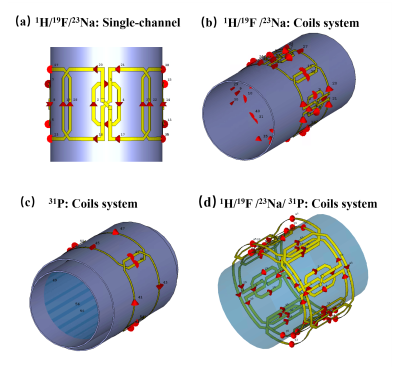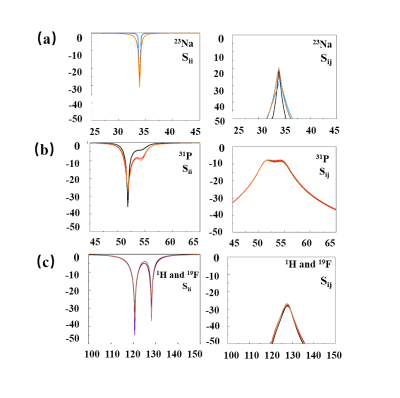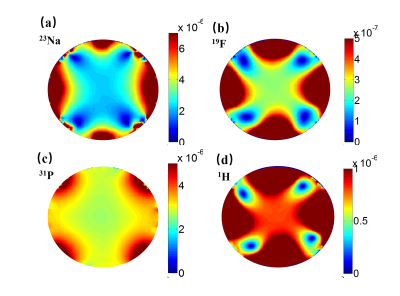4107
A 16-channel quadruple-nuclear RF coil system for 1H / 19F / 23Na/ 31P MR imaging and spectroscopy at 3T1Shenzhen Institutes of Advanced Technology, Chinese Academy of Sciences, Shenzhen, China;, shenzhen, China, 2Department of Biomedical Engineering, Chongqing University of Technology, Chongqing 400054, China, Chongqing, China, 3Department of Biomedical Engineering, State University of New York at Buffalo, NY, United States., Buffalo, NY, United States
Synopsis
Acquisition of multiple nuclear species in MRI/MRS is significant for obtaining metabolic imaging in vivo and biological information. In this study, a16-channel RF quadruple-nuclear coils system capable of 1H / 19F / 23Na/ 31P imaging was designed. Numerical electromagnetic simulation was employed to validate the feasibility and performance of the proposed RF coil system by the scattering parameters and B1+field distributions.
Introduction
The simultaneous acquisition of 1H / 19F / 23Na/ 31P nuclei NMR can be used to complement that acquired from proton (1H) imaging, which can provide information on metabolic imaging in vivo and has the potential for diagnosis and prognosis of pathologies, as well as for therapy monitoring1-3. However, most of acquisitions to detect different MR-sensitive nuclei are mainly dual-tuned probes or coils and limited triple-tuned resonators in small size for small sample MR applications4,5. In this work, a 16-channel of quadruple-nuclear RF coil system capable of 1H / 19F / 23Na/ 31P imaging was proposed and investigated for large sample MR applications at 3T. The feasibility of the proposed 16-channel quadruple-nuclear coils system and the performance were analyzed by the numerical electromagnetic simulation in the scattering parameters and B1+field distributions.Method
The integrated quadruple-nuclear RF coil system was designed in two-layer nested structure as shown in Fig.1. The diameters of inner and outer layer were 15cm and 18cm, respectively. The inner layer coil with 15 diameter consists of four sets of two elements combination, each of which contained a dual-tuned rectangle loop element for 19F /1H Imaging and a butterfly element for 23Na imaging as shown in Fig .1 (a)-(b). The four-channel surface coil phased array for 31P imaging were laid out in the outer layer as shown in Fig1 (c). Each 31P channel was designed with size 163mm x 100mm. The size of channels of 19F /1H were each 30 mm x 50 mm and 23Na were each 143mm x 100mm. The coupling between the butterfly structure of 23Na and middle loop of 1H/19F can be eliminate sufficiently. The distance between the outer layer with 31P coils was 10mm away from the inner 1H/19F /23Na coils to reduce the electromagnetic interference of different nuclides. The decoupling of adjacent channels was all realized by partial geometrical overlapping. A phantom with a diameter of 15cm was used as the coils load to achieve the uniform reception field distributions in the simulations as shown in Fig1 (d). The material properties of the cylindrical phantom were set as: conductivity = 0.6 S/m, relative permittivity εr = 74, and relative permeability μr = 1.Numerical simulations and analysis of the integrated coil system were conducted by Computer Simulation Technology, (Darmstadt, Germany). A Time-domain solver was employed, and the solver accuracy was set to −40 dB in the EM simulations. Boundaries of the RF coil models were all set to open, and the bandwidth was set to 5–300 MHz. The co-simulation method was employed to obtain the values for different tuning/matching networks in the quadruple-nuclear RF coil system of 1H / 19F / 31P/ 23Na. The dual-tuned loops coils were tuned to 128.2 MHz (1H at 3T) and 120.6 MHz (19F at 3T). The butterfly 23Na coils and four-loop 31P arrays were tuned to 33.9 MHz and 51.9 MHz,respectively. The phase of excited ports was set to 0°, 90°, 180°, and 270° in turn to form orthogonal excitation.
The performance the proposed 1H / 19F / 23Na/ 31P quadruple-nuclear RF coil system was evaluated by the S-parameters and B1+ field in the EM simulations. The value of B1+ fields was calculated based on the accepted power normalized to 1 W. The B1+ fields of the central transverse plane from the phantom were reconstructed and analyzed.
Result
The scattering parameters simulation results of the quadruple-nuclear RF coil system for 1H / 19F / 23Na/ 31P imaging are obtained as shown in Fig 2. The average reflection coefficients of the four channels in each frequency was approximately -25 dB in 23Na, -30 dB in 19F, -30 dB in 1H, and -25 dB in 31P,respectively which indicated that the complex 16-channel and quadruple-nuclear coil system has an acceptable tuning and matching effect. The decoupling between nearest neighbor elements of each nuclei is lower than -20 dB in the inner 1H / 19F / 23Na coils, while -10 dB in the outer 31P coils which can be further optimized. The simulated B1+ fields of the quadruple-nuclear decoupling coils were calculated and shown in the Fig.3.Discussion/conclusion
A 16-channel quadruple-nuclear RF coil system for 1H / 19F / 23Na/ 31P MR imaging and spectroscopy was designed for 3T imaging. The scattering parameters and B1+ fields distributions were evaluated by the simulation, which demonstrate the potentiality in multiband array application. The structure of quadruple-nuclear coils will be further optimized by increasing the density of coils and expand the size of the individual channels and the decoupling performance of the coils will be further improved.Acknowledgements
This work was supported in part by NSFC under Grant No. 61571433, 61801466,81627901,81527901, 81830056; Youth Innovation Promotion Association of CAS No. 2017415; city grant JCYJ20170413161314734.References
1. M. Augath, P. Heiler, et al. In vivo 39K, 23Na and 1H MR imaging using a triple resonant RF coil setup. J. Magn. Reson.,134–136, 2009.
2. S. M. Hong, C.H.Choi, et al. Design of a quadrature 1H/31P coil using bent dipole antenna and 4-channel loop at 3T MRI. IEEE Trans. Med. Imag., vol. 37, no. 12, pp. 2613–2618, Jun. 2018.
3. S. E. Ogier, et al. A Broadband Spectrometer for Simultaneous Multinuclear Magnetic Resonance Imaging and Spectroscopy. 24th ISMRM (2016).
4. C. Huang, H. Dong, et al. A triple tuned coil and front-end for simultaneous multinuclear MR imaging and spectroscopy. 27th ISMRM (2019).
5. Y.Ha, C. Choi, et al. Development and Implementation of a PIN-Diode Controlled, Quadrature-Enhanced, Double-Tuned RF Coil for Sodium MRI. IEEE Trans. Med. Imag., vol. 37, no. 7, pp. 1626–1631, July. 2018.
Figures


